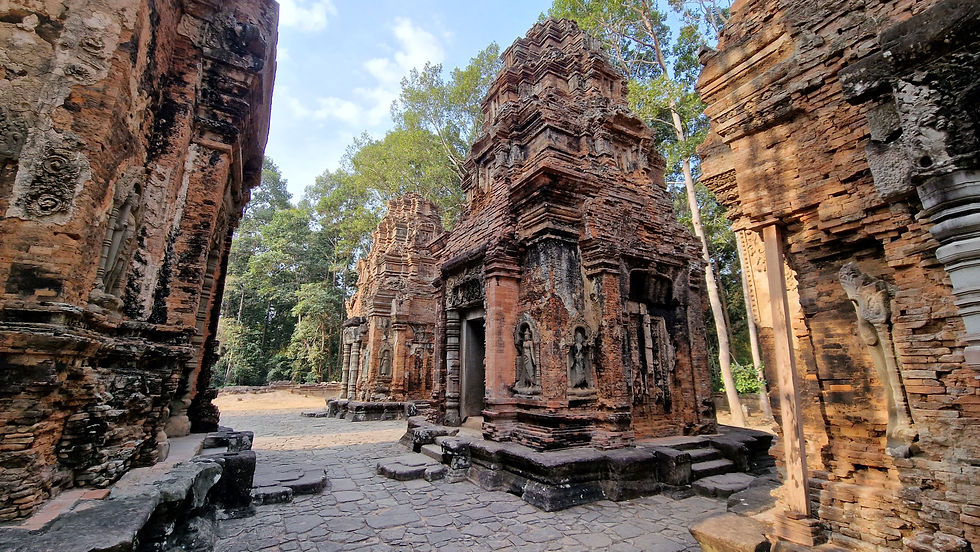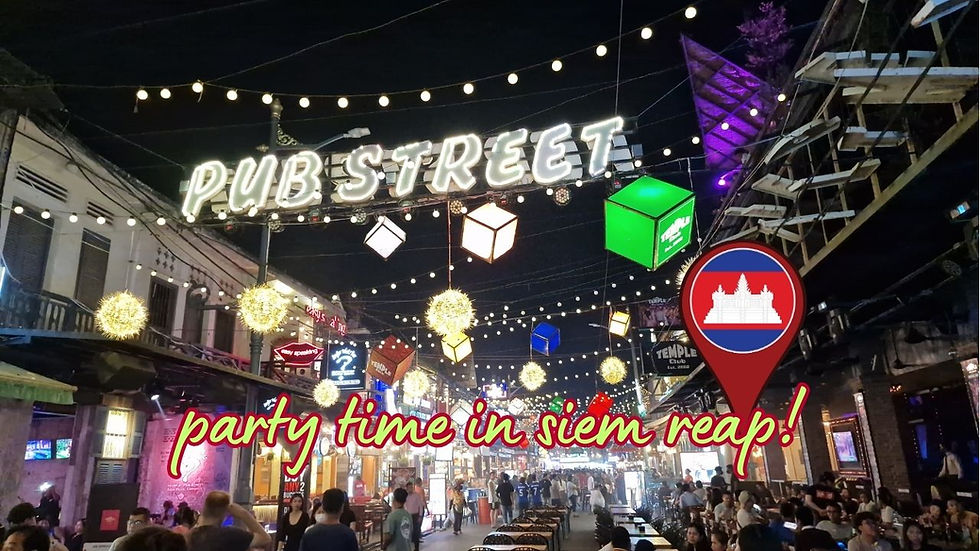Preah Ko Temple Guide: Exploring the Sacred Roots of Angkor, Cambodia
- Jenn & Leon

- Feb 1
- 11 min read
Updated: Nov 2
Located in Cambodia's Angkor Archaeological Park, around 20km from Angkor Wat, Preah Ko Temple is a remarkable archaeological site brimming with history and intricate artistry.
Built in 879 AD as part of the now defunct Hariharalaya capital, it’s often overshadowed by Angkor Wat but holds equal importance as the first royal temple of the great Khmer Empire.

Preah Ko's nickname, “Sacred Bull,” comes from the famous sandstone Nandi statues guarding the site.
These statues stand majestically at the entrance of the temple complex, as symbols of strength and devotion to the Hindu god Shiva.
This guide, from our personal experience and research, explores Preah Ko's history, the legend behind the temple, travel tips, and handy information like opening times and ticket prices.
We are here to help you make the most of your visit. Let's get to it!

In This Post...
Our Preah Ko Highlights
One of the biggest standout highlights for us was the peaceful ambience of Preah Ko compared to other temples of Angkor.
Having spent our first few days at Angkor Wat, it was a welcome change!
Although we are not quite sure why, given the age and prestige of this place.

The beautifully carved sandstone here comes with all of the divine figures and floral motifs synonymous with Khmer architecture.
The six central towers are dedicated to the royal ancestors of King Indravarman I, and when wandering through them, they really do exude an atmosphere of mystery and intrigue.
It very much felt spiritual here; there was a calming energy that seemed to encourage thought and reflection.
While most of the hype surrounding Preah Ko is focused on the Nandi bull statues, which are indeed magnificent, the biggest memory we will have of our visit here is the peace and meaning of this sacred place.
You certainly do feel it, like deep down inside. The close quarters of the towers, their intricate designs, and the orientation towards the sun were well-thought-out.

Then, of course, there is the legend behind the temple, wonderfully told by our guide.
It is the story of two brothers, Preah Ko (the Sacred Bull) and Preah Keo (the Sacred Gem), who possessed mystical powers and brought prosperity to their kingdom.
Preah Ko was believed to be an incarnation of Nandi, the sacred bull of Shiva, and his belly contained precious objects.
The brothers' adventures included encounters with royalty, magical transformations, and acts of courage and sacrifice.

Sacred and historic sites are always a huge attraction to us on our travels, especially when they come with a good story, which they usually tend to.
The story of Preah Ko and his brother is particularly interesting as it literally was the precursor to the rise of the Khmer Empire.
It adds that extra bit of magic to this temple, and one that made our time here that much more special.
Oh, and as a bonus, opposite the Preah Ko temple, is a small but impactful leather carving establishment which houses a superb miniature replica model of Angkor Wat.
It was fascinating to check out this pretty special model, especially having visited the temple itself just a day prior!
Along with learning all about leather carving, too, and the incredible impact this form of art has had on Cambodian society. See more about this tradition in the next section.
We visited over a dozen temples during our time in Siem Reap, and from our experience, we would highly recommend visiting Preah Ko.
If you have limited time or options, you would not be disappointed with making the trip out here.
Whether you are in it for the history, the story, the intricate architecture, or even just the photo opportunities, this one is worth it.

Leather Carving in Cambodia
Cambodian leather carving is a traditional art form that reflects the rich cultural heritage of Cambodia.
This craft involves the meticulous process of designing and carving intricate patterns and images into leather, often depicting themes from Cambodian history, mythology, and nature.
The artisans use various tools to create detailed works that are both functional and decorative.
⪢ Historical Context
The history of leather carving in Cambodia has been influenced by various factors, including the country's tumultuous past, particularly during the brutal Khmer Rouge regime.
This period was marked by severe oppression and a devastating loss of cultural heritage.
Many artisans and craftsmen suffered, and traditional skills were often lost or suppressed.
⪢ Revival of the Art
In recent years, efforts have been made to revive and promote traditional crafts, including leather carving.
Notable initiatives are stores and galleries like the one located opposite Preah Ko.
This establishment was opened with the dual purpose of teaching the art of leather carving and providing support to individuals who suffered under the Khmer Rouge.
⪢ Mission & Impact
The gallery serves as a platform for artisans to learn and practice leather carving, helping to restore their livelihoods and cultural identity.
By providing training and resources, the initiative aims to empower those affected by the Khmer Rouge, fostering both economic independence and a sense of community.
The products created are not only beautiful works of art but also carry stories of resilience and hope.
The History of Preah Ko: Cambodia's First Angkor Temple
Preah Ko, meaning "Sacred Bull," holds a special place in the history of Cambodia as the first temple constructed during the rise of the Khmer Empire.
Built in 879 AD under King Indravarman I, the temple was part of Hariharalaya, the empire’s capital before the famed Angkor Thom.
Dedicated to the Hindu god Shiva, Preah Ko served as a tribute to the king's royal ancestors.

Its six brick towers symbolize this ancestral connection, with three front towers devoted to male ancestors and three rear towers honoring female ancestors.
Intricately adorned with carvings of deities, floral patterns, and mythical creatures, the temple’s architectural design reflects the early evolution of Khmer artistry.
One of the defining features of Preah Ko is its name, which originates from the sandstone statues of Nandi, the sacred bull and Shiva’s mount, placed prominently at the entrance.
These statues not only symbolize devotion to Shiva but also give the temple its serene and spiritual atmosphere.

Preah Ko is notable for introducing stylistic elements that would later define the grandeur of Angkor temples, including decorative lintels and inscriptions in ancient Khmer script, which provide insight into the religious and cultural practices of the time.
Despite its age, the temple has retained much of its original charm, standing as a testament to the early ingenuity of Khmer architects.
As one of the temples in the Roluos Group, Preah Ko paved the way for the construction of iconic monuments like Angkor Wat, making it a must-visit for those interested in the origins of the Khmer Empire.

⪢ The Khmer Empire: An Overview
The Khmer Empire was one of Southeast Asia's most powerful and influential civilizations, flourishing between the 9th and 15th centuries.
Centered in present-day Cambodia, the empire's influence extended into modern-day Thailand, Laos, and Vietnam.
It is best known for its incredible architectural achievements, particularly the construction of Angkor Wat, the largest religious monument in the world.

The Khmer Empire was deeply rooted in Hinduism and later Buddhism, which shaped its art, architecture, and culture.
Kings were considered divine rulers, often commissioning massive temple complexes to honor deities and solidify their spiritual and political authority.
The empire's prosperity was largely built on an advanced irrigation system that allowed for the cultivation of rice, supporting a large population and enabling significant economic and cultural growth.
At its height, the Khmer Empire was a hub of innovation, producing intricate stone carvings, monumental temples, and detailed inscriptions that provide a glimpse into its sophisticated society.
However, the empire declined in the 15th century due to factors like invasions, shifts in trade routes, and environmental challenges.
Despite its fall, the legacy of the Khmer Empire endures through the magnificent ruins of Angkor, which continue to captivate the world.

Tips for Visiting Preah Ko and the Angkor Site
⪢ What to Wear
Respectful attire (covering your shoulders and knees) is not openly required here, as is the case with most of the temples in Angkor.
That being said, it is worth bringing a cover-up just to be on the safe side.
⪢ Essentials
Bring water, sunscreen, and comfortable shoes, as there is little to no shade on this particular site.
⪢ Photography
Early visits offer the best natural lighting and fewer crowds for photos. We also recommend heading to the back of the temple, where the platform is higher than ground level.
It is a great spot for photos like the thumbnail of this post, especially if you can catch the sun in between the towers.
⪢ Pairing with Nearby Temples
Visit nearby Bakong and Lolei for a comprehensive exploration of the 'Roluos Group' of Hariharalaya temples.

Angkor Pass Tickets for Preah Ko
Terrace of the Elephants is part of the Angkor Archaeological Park; entrance is included with your park ticket.

● 1-day pass: USD 37
● 3-day pass: USD 62 (valid within 10 days)
● 7-day pass: USD 72 (valid within 1 month)
Prices are correct at the time of writing (June 2025).
All prices are in United States Dollars. Convert your currency here.
Preah Ko Opening Hours & Best Time to Visit
⪢ Opening Hours
● Open daily from 7:30 am to 5:30 pm
● Early arrival is advised to avoid midday heat and crowds.
⪢ Best Time to Visit
● Early morning (7:30 am – 9:00 am): Cooler temperatures and quieter surroundings make for a peaceful visit.
● Late afternoon (4 pm – 5:30 pm): Softer light enhances the temple’s reddish sandstone and intricate carvings.
● Dry season (November to February): Offers the most comfortable weather with less humidity and minimal rain.
● Avoid visiting during the hottest hours between 11 am and 3 pm when the sun is strongest.
💡 Tip: Combine your visit with nearby temples in the Rolous Group for a full-day cultural experience.

How to Get to Preah Ko
Preah Ko is part of the Rolous Group of temples, located about 13 km east of Siem Reap town center. It’s one of the earliest Khmer temples and a must-see for those interested in Angkor’s origins.
By Tuk-Tuk or Taxi
From Siem Reap, it takes about 25–30 minutes by tuk-tuk or taxi to reach Preah Ko.
Many tuk-tuk drivers offer half-day or full-day tours that include Preah Ko along with other temples in the Rolous Group, such as Bakong and Lolei.
Tuk-tuk fares range between USD 15 - 25 for a combined temple tour, negotiable depending on your itinerary.
By Bicycle
For cycling enthusiasts, Preah Ko is accessible via flat roads east of Siem Reap, roughly a 30–45 minute ride.
Bring water and sun protection, and use a map or GPS for navigation.
By Group Tour or Shuttle
Several tour operators offer guided excursions to the Rolous Group temples, including Preah Ko.
These usually include hotel pickup, transport, entry fees, and a knowledgeable guide.
GetYourGuide Tour Option
For a hassle-free experience with skip-the-line access and expert guides, consider booking an Angkor tour via GetYourGuide. These tours often include:
● Hotel pickup and drop-off from Siem Reap
● Entry fees included
● Guided exploration of Angkor and its temples
● Small group sizes for a personalized experience
🎟️ Book your Angkor Tour on GetYourGuide
Where to Stay Near Preah Ko
Looking for a place to stay nearby? Browse Siem Reap hotel deals below to find great rates from top providers in the city.
Our map offers a user-friendly interface that allows you to zoom in and out, providing a comprehensive view of the area and enabling you to identify the most convenient hotel options based on your current location or desired destination.
Other Must-See Temples Near Preah Ko
Bakong Temple

The largest temple in the Rolous Group, Bakong, is a massive pyramid-shaped structure that set the standard for temple architecture.
Lolei Temple

Situated on an island in the ancient Indratataka Baray reservoir, Lolei features four brick towers dedicated to Shiva and his family.
Koh Ker Temple

Though farther afield, Koh Ker is known for its impressive seven-tiered pyramid and unique, remote setting.
Prasat Preah Palilay

A jungle temple with charming Buddhist carvings and a tranquil atmosphere, ideal for a peaceful visit.
Watch the Angkor Sunrise on YouTube
Angkor Wat is indeed a bucket list destination for many people, being the largest spiritual complex on earth!
In this video, we share with you some of our incredible sunrise footage from Angkor, along with some tips on how to make your morning and day go a little smoother.
We also show you where to pick up your temple day (or week) pass (you must be present as they take a photo and give you a tangible card).
If you enjoy our video and want to follow more of our adventures, please like and subscribe!
Your support truly is invaluable to us, and we will always strive to produce the best content we can from around the world!
Our Experience Rating:
Preah Ko

Of all the temples we saw in Angkor, amongst all the individual brilliance, Preah Ko is a standout for its energy and history.
One of the oldest and also one of the most significant, we felt the energy here almost immediately.
The way the sun projects between the towers and the platform at the back, which allows for stunning photos, has left a memory we will never forget.
Preah Ko is not just about architecture and marvel. There is something at this site that literally runs deeper. A special temple. A special place. Don't miss it!
FAQ: Preah Ko Temple – What You Should Know
What is Preah Ko Temple?
Preah Ko (meaning “Sacred Bull”) is one of the earliest temples of the Khmer Empire, built in 879 AD by King Indravarman I.
It was dedicated to Shiva and the king’s ancestors, and is the first temple in the Roluos Group.
Where is it located?
Preah Ko is situated in Roluos village, about 15 km southeast of Siem Reap. It’s one of three key temples in the Roluos Group, along with Bakong and Lolei.
Do I need a ticket to visit?
Yes, you’ll need the Angkor Pass, which covers Preah Ko and all temples in the Angkor Archaeological Park, including Angkor Wat and the Roluos temples.
What makes Preah Ko unique?
It features six brick towers, arranged in two rows on a sandstone platform.
Each tower is adorned with beautiful stucco carvings, Sanskrit inscriptions, and guardian statues.
The temple gets its name from the statues of Nandi (Shiva’s sacred bull) facing the central towers.
💡 Don’t miss the lion statues at the stairways and the delicate false doors — they’re among the best-preserved in Angkor.
What are the opening hours?
Preah Ko is open daily from 7:30 am to 5:30 pm, in line with most temples in the Angkor complex.
How long should I spend here?
Plan for around 30–45 minutes, especially if you’re combining it with Bakong and Lolei on the same trip.
Is it crowded?
Rarely. Preah Ko receives far fewer visitors than the main Angkor temples, making it perfect for quiet exploration and photography.
Is there a best time of day to visit?
Morning light works well for photos, and the cooler hours help you avoid the midday heat, but since crowds are minimal, you can visit anytime.
Is it Buddhist or Hindu?
Preah Ko is a Hindu temple, specifically dedicated to Shiva. It reflects the pre-Angkorian architectural style and religious focus before the later Buddhist influence.
What’s nearby?
Bakong Temple (larger and pyramid-shaped)
Lolei Temple (known for its lotus pond setting)
All are part of the Roluos Group and usually visited together as a half-day trip from Siem Reap.












































.png)

.png)





















































A stunning temple that is not always on the radar when it comes to the temples of Angkor. It's kind of what makes it so special! It is quiet, typically beautiful, and full of powerful energy. An amazing place.